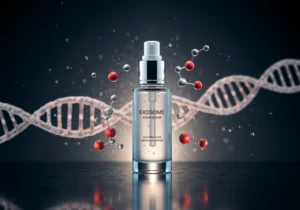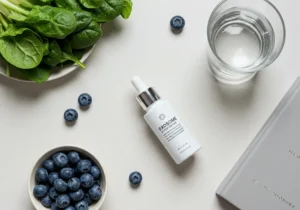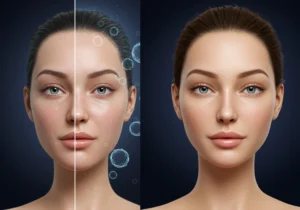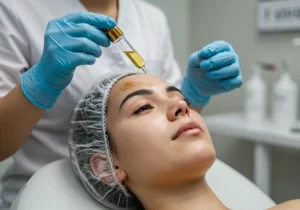Skincare has always evolved alongside science. From natural botanicals to advanced peptides, each generation discovers new tools for maintaining youthful and healthy skin. In 2025, the most talked-about breakthrough is the exosome serum. Unlike traditional creams that work on the surface, these serums aim to repair and rejuvenate the skin from the inside out, using biotechnology that communicates directly with your cells. But what exactly are exosomes, how do they work, and why are they being called the future of anti-aging skincare? Let’s explore.
What Are Exosomes?
Exosomes are tiny extracellular vesicles naturally produced by cells in the body. They function as messengers, carrying proteins, lipids, and genetic material between cells. Think of them as delivery packages — when one cell wants to influence another, it sends an exosome filled with information. Scientists are now harnessing this communication system to encourage skin cells to repair themselves.
According to the National Institutes of Health (NIH), exosomes play a crucial role in tissue regeneration, immune regulation, and wound healing. In dermatology, this makes them particularly attractive for promoting collagen production, reducing inflammation, and repairing damage caused by UV rays or pollutants.
How Do Exosome Serums Work?
When applied topically, exosome serums deliver bioactive signals that stimulate skin cells to act younger and healthier. Instead of forcing turnover (like retinoids do), exosomes encourage natural regeneration. Here’s what that looks like in practice:
- Collagen stimulation: Exosomes tell fibroblasts to produce more collagen, reducing fine lines and sagging.
- Anti-inflammatory action: They reduce cytokines associated with redness and irritation, improving conditions like sensitive skin and rosacea.
- Barrier repair: By enhancing lipid production, exosomes strengthen the skin barrier, locking in hydration.
- DNA protection: Some research suggests exosomes may carry antioxidants and protective enzymes that defend against oxidative stress.
Studies published in The Journal of Investigative Dermatology highlight that exosome-based treatments may accelerate healing and improve scar outcomes, paving the way for their cosmetic applications.
Benefits of Exosome Serums
So, why should skincare enthusiasts pay attention? Exosome serums may provide benefits that go beyond what’s possible with traditional anti-aging products:
- Anti-aging results: Wrinkles, crow’s feet, and fine lines appear reduced as collagen density improves.
- Skin tone balance: They help reduce hyperpigmentation by calming overactive melanocytes.
- Improved hydration: Barrier repair ensures moisture stays locked in, combating dryness.
- Accelerated healing: Useful for post-procedure recovery (microneedling, laser treatments).
- Long-term resilience: Instead of short-term plumping, exosomes encourage natural repair processes that benefit skin over time.
Are Exosome Serums Safe?
Safety is one of the most important considerations with any new cosmetic technology. While early results are promising, regulation around exosome products is still evolving. Dermatologists recommend selecting products from brands that provide clear sourcing, clinical data, and third-party safety testing.
According to Cleveland Clinic, exosomes are being investigated for medical therapies ranging from cancer to heart disease, which underscores their biological importance. However, because exosome skincare is still relatively new, consumers should proceed with informed caution.
How to Choose the Right Exosome Serum
If you’re considering adding an exosome serum to your routine, here’s what to look for:
- Origin: High-quality serums are often derived from plant stem cells or lab-cultured sources with transparent manufacturing.
- Purity: Brands should provide sterility and safety certificates.
- Formulation: Look for supporting ingredients like peptides, hyaluronic acid, or niacinamide for synergistic effects.
- Delivery: Advanced encapsulation methods (liposomes or nano-carriers) ensure exosomes penetrate deeply.
Consumers should be wary of products with vague claims or no supporting research. As Harvard Medical School points out, the study of cell-to-cell communication is complex, and not all products on the market are equally effective.
Incorporating Exosome Serums Into Your Routine
One of the advantages of exosome serums is their versatility. Here’s how to integrate them:
- Cleanse your face with a gentle, pH-balanced cleanser.
- Apply a toner or essence to prep the skin.
- Dispense 2–3 drops of exosome serum and pat it gently into your skin.
- Layer with a hydrating moisturizer or oil to lock in benefits.
- In the morning, finish with broad-spectrum sunscreen (SPF 30+).
Consistency is key. Most experts recommend starting with 2–3 applications per week before moving to daily use.
Exosome Serums vs Traditional Anti-Aging Treatments
How do exosome serums compare to tried-and-true treatments like retinol, peptides, or vitamin C?
- Retinoids: Effective but can cause peeling and irritation. Exosomes are gentler.
- Peptides: Stimulate repair but act more slowly. Exosomes provide a broader range of signals.
- Vitamin C: Great for brightening, but less effective for collagen synthesis compared to exosomes.
- Growth factors: Similar concept, but exosomes may deliver more targeted results by carrying multiple signaling molecules.
Some dermatologists suggest combining exosomes with these traditional actives for a layered, synergistic approach.
The Holistic Connection: Beauty From Within
Skincare works best when paired with healthy lifestyle choices. Cellular repair thrives when your body has the right building blocks. Here’s how to support exosome serum use with holistic beauty practices:
- Nutrition: Antioxidant-rich foods (blueberries, leafy greens) protect against oxidative stress.
- Hydration: Drinking enough water supports skin elasticity from within.
- Sleep: Deep sleep is when most cellular repair occurs.
- Stress reduction: High cortisol levels accelerate aging — mindfulness practices can help.
Holistic beauty is about synergy: internal wellness enhances external treatments. By combining exosome serums with mindful lifestyle habits, you maximize results.
Challenges and Limitations
Despite the hype, there are challenges worth noting:
- Regulation of cosmetic exosome products is still unclear.
- Scientific studies are ongoing — long-term effects aren’t fully known.
- Cost can be high, as biotech formulations are expensive to produce.
Still, as with many innovations, early adoption often comes with higher prices and limited availability.
What Does the Future Hold?
The future of exosome skincare looks bright. Researchers are exploring applications in regenerative medicine, scar therapy, and even hair regrowth. Beauty brands are beginning to combine exosomes with artificial intelligence to deliver personalized skincare recommendations. Imagine scanning your skin with a smartphone, receiving a hydration report, and being recommended a specific exosome formula tailored to your cellular needs.
Conclusion
Exosome serums represent more than a beauty trend — they mark a paradigm shift in how we approach skincare. By working with the body’s natural communication system, they encourage true cellular repair and regeneration. While more research is needed, early evidence suggests they may soon become a cornerstone of advanced anti-aging skincare. For those seeking results that go beyond the surface, exosome serums offer a glimpse of the future where beauty truly begins from within.









